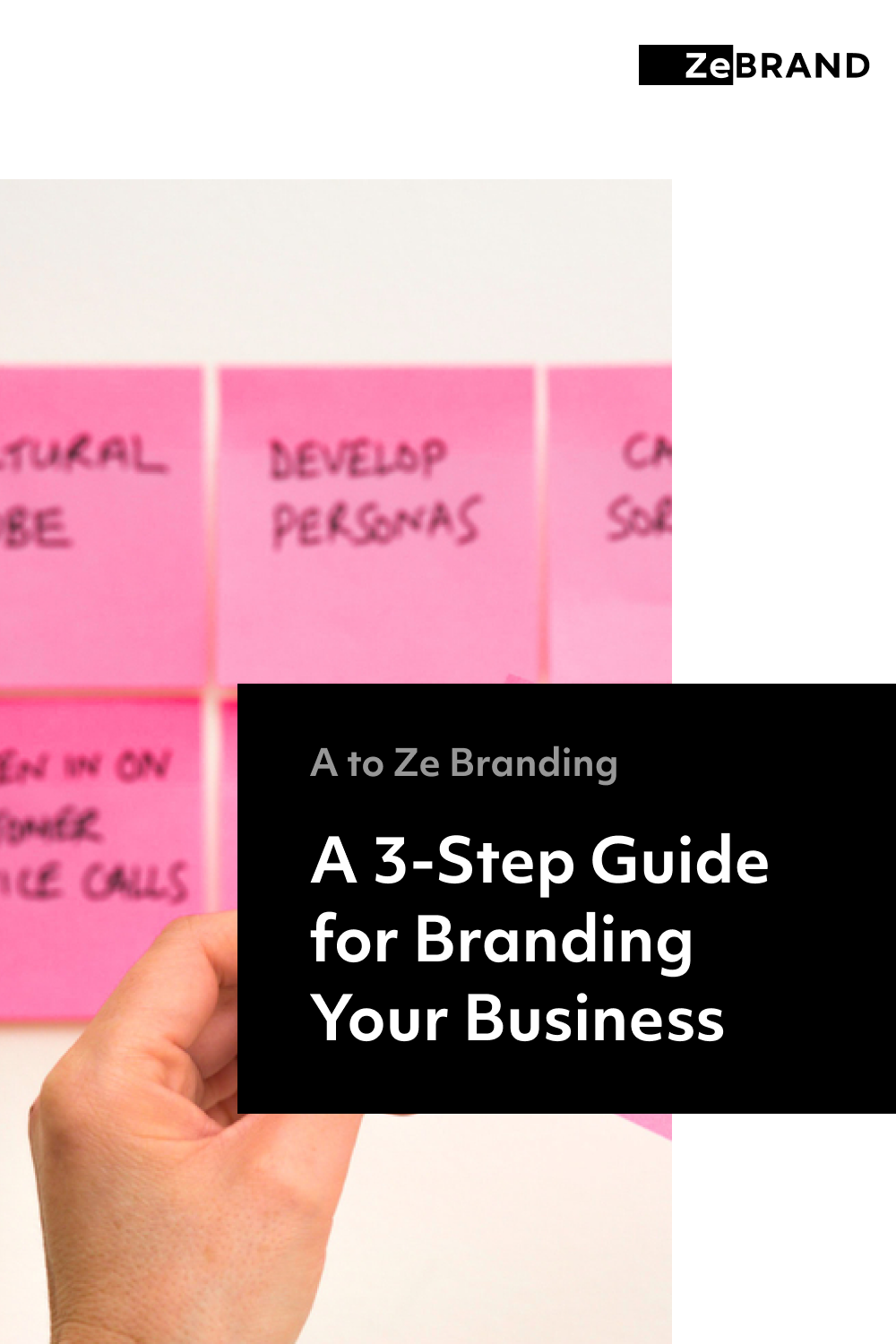A 3-Step Guide for Branding Your Business

Conduct some dedicated research to understand your potential customers’ priorities and needs.
When you are building up your business, you will hear the terms ‘brand’ and ‘branding’ often. A brand gives your business an identity and creates awareness amongst customers, investors, partners and even your own employees. This may seem like a burdensome, expensive task. But it may not be as complicated or as expensive as you think. Follow our 3-step guide on how you can get started. But before that, let’s define what branding entails.
What is a brand and why is branding important for your business?
A lot of people confuse business with brand. A ‘business’ is your startup or company which produces services or products. A ‘brand’ on the other hand is how someone perceives your business. In the early stages of development, small businesses often put their focus on building their product, services, and client base. While it is essential to get a good foundation in place, branding oftentimes ends up being overlooked. In today’s competitive environment, consumers make fast-paced decisions about which brands they choose and then stick to. So do investors. Making a good first impression is essential, and this is where good branding can help your business.

Photo by Ricardo Gomez Angel on Unsplash
The 3-step guide for building a brand for your business
1. Determine your target audience
Having a defined target audience is important because it gives you focus. Having a wide and diverse audience may dilute your communication efforts. Here are some key things you can do in order to find out who your target audience is.
1) Conduct research
Conduct some dedicated research to understand your potential customers’ priorities and needs. Typically, the best place to start is with your current user base. Start by delving into analytics – from your site (eg. Google Analytics) or social media (eg. LinkedIn, Facebook, Instagram). What is the age, background, spending capacity of your ideal customer? What are their interests? What life stage are they in? Once you compile some highlights, you will have a better understanding of who your high-value customers are. At the same time, looking at new customer behavior can tell you about who your ideal target audience should be.
2) Check your competition
Find out who your key competitors are. This can be done easily by doing a quick search on Google to see what kind of businesses are creating content or ads for keywords related to your industry. Looking at industry reports from the likes of Gartner, Mintel will also give you some idea of your key competitors within your industry. Look at how they are communicating with your target audience. Is their strategy like what you envisioned? Competitor analysis may open up new opportunities, eg. a new target audience you hadn’t previously considered.

Photo by Dimon Blr on Unsplash
3) Be clear on your business’ value proposition
Once you understand your target audience a bit better, you should think about what their needs are. How is your business going to help answer those needs in a unique way? IKEA does a great job of aligning their products and communications to specific target audience groups -- an example is its campaigns targeting students with cost-effective furniture.

Photo by Riccardo Annandale on Unsplash
Here are some practical ways on how you can articulate your business’ value proposition:
① List your product’s core benefits.
② List your customers’ needs and any problems associated with those needs (eg. want furniture, but don’t have much money).
③ From ①, mark out those benefits which are most relevant to ② and then write down what your customers can expect from your product.
④ Write down what differentiates you from your competitors.
2. Develop your brand identity
Based on an understanding of your audience, establish your brand identity. While logos and visuals are extremely important for your brand, a brand identity is more than that. A brand identity is made up of a company’s personality, values and vision. Here are some things to consider when you build your brand identity.
a. What is your brand’s personality?
Think about what attributes can be associated with your brand. Are you a traditional and luxury brand like Burberry or are you playful like Coca-Cola?
b. Tone of voice
A company’s tone of voice will define all its communications. It’s about how you say things. Once you understand your brand’s personality, your business proposition and your brand values, your tone of voice can stem from that. You can start using your defined tone of voice in your emails and social media and test to see what works.

Photo by Jason Leung on Unsplash
c. Have a mission statement
This is a simple sentence articulating the core purpose of your business. For instance, Google’s mission statement is: “To organize the world’s information and make it universally accessible and useful”. Having a clear mission statement is also useful when pitching to investors or motivating your employees.
d. Branding Design
This is the look and feel of your brand and a very important aspect of branding. Choosing the right logo, color palettes for visuals, the appropriate font and sticking with it, all go a long way in showing consumers and investors that you are consistent in how you communicate. The cost may sometimes seem prohibitive to invest in your brand visualization. However, this is a core aspect of branding and has far reaching implications on your business. For example, Airbnb’s launch of their logo, ‘bélo’ was much talked about because it was simple, consistent and easily recognizable. Depending on what process you use, it can also be cost effective. Here’s a free and simple exercise by ZeBrand that you can run through to define and create your brand identity, as well as to download the associated brand toolkit and assets from.
3. Communicate with your target audience
Having established your target audience, your brand identity, and your product, you can now think about strategic marketing tactics. Once you know how to talk about yourself, it becomes much easier for others to understand your product and services. Once you have a great brand toolkit, you can start thinking about the best way to showcase your product to a well-defined audience using different kinds of marketing. Some important things to think about when creating your marketing campaign are:

Photo by Markus Winkler on Unsplash
・Understand your target audience
By now, you have already established your target audience. It’s also essential that you understand how they behave. Where do they normally spend their time? Conducting some demographic research can help you get closer to your target audience.
・Find the right channel
There are several ways to communicate to your audience –- search ads, websites, social media, billboards, television and more. A good understanding of your audience can help you figure out which channel to use. For example, if your target audience consists of young teens, they may be spending a lot of time on social media like Instagram, Snapchat, TikTok, etc. Having targeted and engaging social ads could be one way of reaching them.
HubSpot is a great example of a business that got its content marketing on point and then went on to become an established business with over 2600 employees. By identifying brand personas for their core audience, they created an elaborate content strategy that helped answer the needs of their customers.
If your business is ultimately about driving people in store, then you may want to try more offline channels like billboards.
・Align your communication goals and your budget
While your goals may be very ambitious, you must think about how much budget you can afford for your communication plan. Low budget doesn’t mean lesser communication -- you can also be smart and effective. For example, when Spotify was launching in the US, it used private ‘beta’ invites to help create excitement. Those users then shared their experiences on social media; the exposure led to organic growth.

Photo by Kelly Sikkema on Unsplash
Summary
Building your brand from scratch may sound a little overwhelming but by starting with a basic strategy, you can find out what works and what doesn’t and then go back to tweak it. Some businesses even go back and overhaul their branding by rebranding themselves. For instance, in 2015, after a major restructure of its organization,Google changed the typeface of its logo from a serif to a sans serif font. It was the biggest change they made to their logo after 1999.
Branding is an iterative process and it will keep evolving as you grow your business.

ZeBrand can help you in building your brand from scratch. Find out how in this short video.


